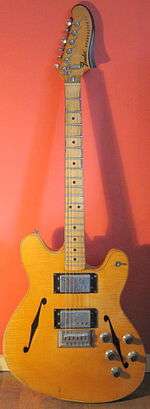Fender Starcaster
The Fender Starcaster is a semi-hollowbody electric guitar made by the Fender company. The Starcaster was part of Fender's attempt to enter the semi-hollowbody market, which was dominated by Gibson's ES-335 and similar designs.
| Fender Starcaster | |
|---|---|
 | |
| Manufacturer | Fender |
| Period | 1976–1982, 2013–present |
| Construction | |
| Body type | Semi-hollow |
| Neck joint | Bolt-on neck |
| Scale | 25.5" |
| Woods | |
| Body | Maple |
| Neck | Maple |
| Fretboard | Maple |
| Hardware | |
| Bridge | Fixed |
| Pickup(s) | H–H: Fender Wide Range |
| Colors available | |
| White, Natural, Sunburst, Walnut & Black | |
Design and production
The Starcaster was designed by Gene Fields to be a high quality instrument, although it was manufactured at a time when Fender's standards had lowered considerably. Unlike most semi-hollow guitars which had their necks set in the bodies in the traditional style, the Starcaster retained Fender's bolt-on neck design, which at the time, used a three-bolt joint.
The Starcaster was in production from 1976 to 1982. However, an advertisement from 1977 states that the Starcaster's first creation was in 1975.[1]
Re-use of Starcaster name
The Starcaster name was revived for a range of "value-priced" Starcaster by Fender guitars, basses, and drums unrelated to the Starcaster of the 1970s. The guitars were usually the same shape as Fender's Stratocaster and the bass the same shape as the Fender Jazz Bass.
2013 Reissue
In September 2013 Fender reissued the Starcaster in continuation of its 2011 "Modern Player" series. The new version, offered in black, natural or aged cherryburst, closely resembles the original guitar but lacks some key features including the master volume control, string-through-body bridge, string tree for four strings, bullet truss rod adjuster and three-bolt neck attachment. Unlike the original from the 1970s, the new guitar features a tune-o-matic bridge with a stop tailpiece and bound f-holes.
Fender has also released a bass version of the Starcaster, an instrument that was never released, although at least three prototypes were created in the mid 1970s. The name "Starcaster Bass" is purely speculative as the existing prototypes have only the name Fender on the headstock, a feature which the new version retains.
Popularity
The Starcaster was commercially unsuccessful, perhaps because of a public notion that Fender was a "solid-body, single coil brand" and Gibson was the "semi-hollow, humbucker brand". As a result, Starcasters are very rare, but are worth less in today's vintage market than many other semi-hollow guitars from the same period to collectors because of their unpopularity and lack of name endorsers at their time of manufacture.
The most prominent player to use the original 1970s Starcaster was Leo Nocentelli of The Meters. Their songs "Cissy Strut" and "Look-Ka Py Py" are considered funk classics.
Claydes Charles Smith of Kool and the Gang can be seen using one in the video for "Celebration".
Several modern high-profile guitarists use the Starcaster as a preferred instrument. Jonny Greenwood, guitarist of Radiohead, can frequently be seen playing a Starcaster on stage. Sammy James, Jr., guitarist and front man of the Mooney Suzuki, uses a natural finished one and appeared on Late Night with Conan O'Brien with it on June 21, 2007. The guitar can also be seen in the music video to Morrissey's single "You Have Killed Me". Dave Keuning of The Killers also started using one shortly before the release of the album Sam's Town. He could be seen playing his Starcaster during The Killers' headline slot at Glastonbury Festival 2007, on Later... with Jools Holland for "Read My Mind" and in the videos for "For Reasons Unknown" and "Human". Scott McMicken of Dr. Dog employs the Starcaster as one of his main guitars, along with an Epiphone Sheraton II and a Gibson ES-335.
Trey Anastasio of Phish plays a custom Languedoc guitar based on the Starcaster. Arctic Monkeys guitarist Jamie Cook can be seen playing one at the 2009 Reading Festival and in the video for the 2009 single "Crying Lightning". Chris Walla of Death Cab For Cutie has occasionally used a Starcaster live. As mentioned on the Roderick on the Line podcast, John Roderick of The Long Winters owned and played a Starcaster.[2] Mark Hempe of the New Orleans-based funk quintet Earphunk played a starcaster at the 2016 Major Rager in Augusta, Ga. British rock band Royal Blood's Mike Kerr is often seen using either a black or custom-made white (never released commercially) Starcaster Bass in various music videos and tours.
Construction
The Starcaster has a unique headstock design, with a black bottom curve. No other production Fender guitar before or since had the same headstock, but some prototypes of the Fender Marauder, also designed by Fields, had a similar headstock design and also reminiscent of the Ibanez Roadstar and Blazer series. It was also unusual for a semi-hollow guitar in having an asymmetrical ("offset") body, a maple fretboard, a bolt-on neck, a novel control configuration consisting of a volume and tone control for each pickup as well as a master volume control, and Fender's traditional six-on-a-side tuning pegs.
Notes
- Vintage Fender advertisement (1977). - The Hard-Charging Sharp-Toothed Starcaster
- Mann, Merlin; Roderick, John (12 December 2016). "Ep. 227: "Fifth Knob"". Roderick on the Line (Podcast). Retrieved 13 December 2016.
External links
| Wikimedia Commons has media related to Fender Starcaster. |